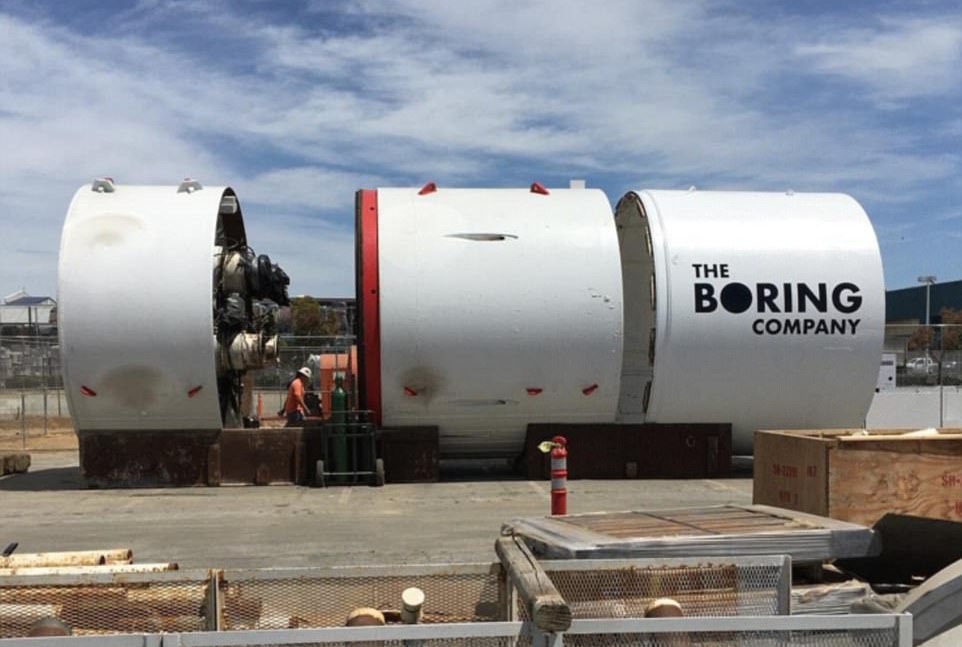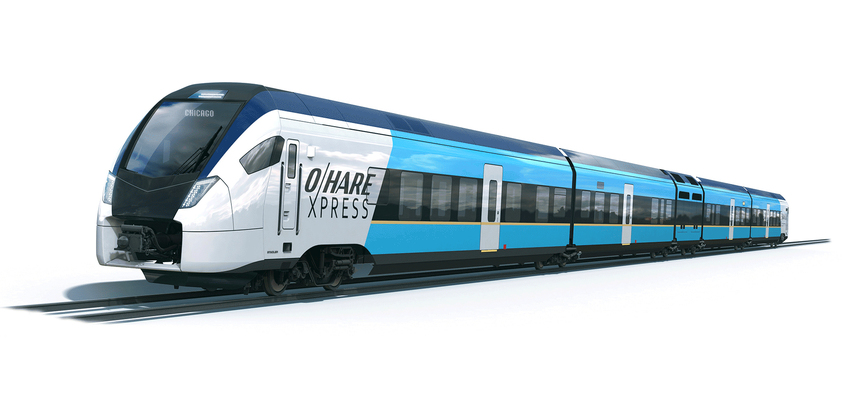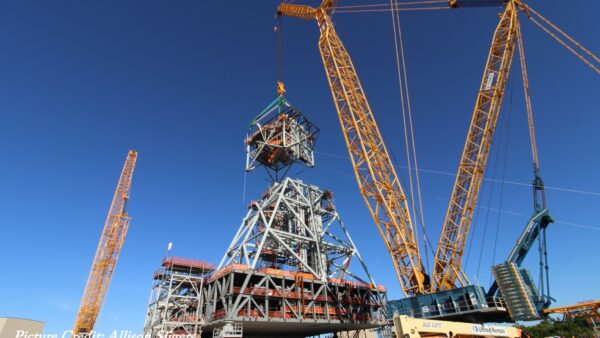Visionary Elon Musk just made history by launching the world’s first private rocket into space, but he also wants to plumb the bowels of the earth by making his futuristic Loop transit system the long-mulled new link to Chicago’s O’Hare airport.
Four potential bidders, including Musk’s The Boring Company, have responded to a request for qualifications (RFQ) put out by the city of Chicago, which is looking to build a rail link to O’Hare on a public-private partnership (PPP) basis.
He has never built a commercial-scale tunnel before and his vision for what he’ll put in it – a high-speed, autonomous mass transit system – is still in the conceptual phase.
But if officials are taken with his ideas, he would design, build, finance, and operate the O’Hare Express.
Three other entities have also thrown their hats into the ring, as revealed by the Chicago Infrastructure Trust.

A small tunnel boring machine, named “Godot”, on the premises of The Boring Company (The Boring Company)
One is Oaktree Capital Management, and two other consortiums call themselves O’Hare Xpress and O’Hare Express Train Partners. As expected, these two comprise teams including contractors, engineers, transport firms and financiers.
The UK’s Mott MacDonald, Spain’s OHL and Italy’s Ansaldo STS are on the teams. (See end for details.)
The fourth interested party, on its own, is The Boring Company.
Whizzing through tubes
Musk started The Boring Company in December 2016 with an ambitious goal to cut the cost of tunnelling to a tenth of what it is now (about a billion dollars a mile, he says), while dramatically ramping up the speed of tunnel construction.
He believes this can be done by making tunnels narrower – 14 feet in diameter rather than the standard 28 feet – and by rethinking the traditional tunnel boring machine (TBM) to make it faster and able to run continuously. (Read more about this vision here.)
Cheaper, faster tunnelling would be necessary for Musk’s dream of the Hyperloop, in which people-carrying pods whiz through a vacuum tube at more than 600mph, a system Musk sees replacing medium-haul air travel between cities.
Such tunnels would also be necessary for his vision of “3D” urban transport, where the problem of surface gridlock is solved by deep, interlocking tunnel networks through which autonomous electric vehicles called “skates” travel at up to 150mph.

Consortium member Antarctica Capital’s image of the new O’Hare link train
Skates wouldn’t need 28-foot-diameter tunnels, and could propel people-carrying pods for an urban mass transit system, or act as self-driving trailers for cars, which would access the tunnel system, called just “Loop”, through surface-level lifts.
Breakthrough soon?
Ordinarily an idea like this would be dismissed as science fiction, but Musk has a record for bringing paradigm-shifting visions to fruition. His Tesla electric vehicles have been best sellers in certain recent years, and on 6 February his company Space X became the first private corporation to launch a rocket, the SpaceX Falcon Heavy, into orbit.
In considering The Boring Company for the O’Hare link, Chicago will have to consider that Musk has not yet built a commercial scale tunnel, and his transport systems are still in proof-of-concept stage.
But Musk is working hard to get his ideas applied in the real world, and it may be just a matter of time before he gets his break.
The State of Maryland has granted The Boring Company permission for 10.1 miles of tunnel under the state-owned portion of the Baltimore-Washington Parkway. This is part of a bigger plan to build a Loop system from Washington, DC to Baltimore, which would then be extended to New York.
In January, Musk proposed a 6.5-mile tunnel under Culver City, Los Angeles, to relieve “soul destroying” traffic congestion there.
Watch this video depicting how cars and pods could access a subterranean Loop system.
Who else is in the frame?
As for the other respondents, Oaktree Capital Management is somewhat unusual, being a Los Angeles-based investment manager that has until now specialised in corporate and distressed debt.
The other two entrants are more like conventional PPP consortiums, although O’Hare Xpress has three investors and no general contractor, whereas O’Hare Express Train Partners has two contractors and no investor.
O’Hare Xpress is made up of French infrastructure investor Meridiam; Antarctica Capital, an investment manager with operations in the US, the UK and India; and JLC Infrastructure, the investment vehicle founded by former basketball player Magic Johnson. The engineer is the UK’s Mott MacDonald and the operator is First Transit, the Cincinnati-based subsidiary of Scottish transport provider FirstGroup.
O’Hare Express Train Partners is made up of Spain’s OHL Infrastructure; Kiewit, the Omaha-based contractor that is owned by its employees; Amtrak; and the transport company Ansaldo STS, based in Genoa.
Short on detail
The project brief leaves most of the details of the scheme to the bidders, including whether the link is on, over or below ground. However, the entrants should halve the time taken to get between downtown Chicago and O’Hare to less than 20 minutes for a price that is competitive against other modes of transport.
The project is expected to cost upwards of $1bn, which has concerned Chicago residents, who point out that the airport already has a rail link, provided by the Blue Line service.Â
To that, the city has responded that passenger numbers are expected to grow 75% in the next 30 years, and that the up-front cost of the new link will be met by the private sector – although ultimately paid for by commuters.
Top image: A Blue Line train on its way from California Station (in Chicago) to Forest Park (Cragin Spring/Creative Commons)
Further reading:






